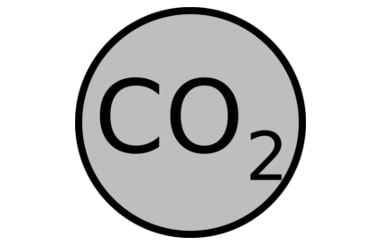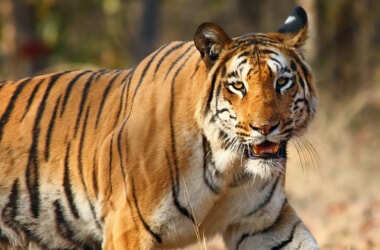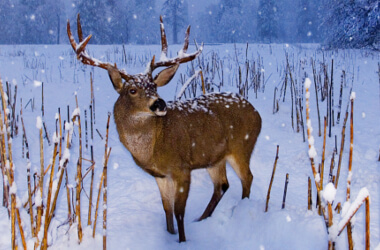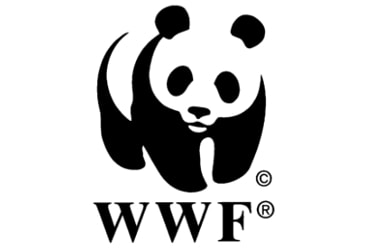▼ Carbon dioxide crosses 400 ppm limit in atmosphere! [10-26-16]
 The World Meteorological Organisation on 24th Oct 2016 released the annual GHG bulletin The World Meteorological Organisation on 24th Oct 2016 released the annual GHG bulletin
- As per the bulletin, the average level of CO2 in the atmosphere across the globe passed 400 parts per million in 2015
- The statistics released by the WMO points to the damage of the rising CO2 levels and the impact of climate change
- The WMO GHG bulletin reports on atmospheric concentrations of GHG
- CO2 accounted for 65% of the radiative force by long-lived GHG
- The pre-industrial level of 278 ppm represented a balance between the atmosphere, oceans and biosphere
- Human activities have altered the balance and in 2015, globally averaged levels were 144 percent of pre-industrial levels
- In 2015, the global annual average concentration of CO2 reached 400 ppm
- The increase of CO2 from 2014–2015 was larger than the previous year and the average over the past 10 years
- Reducing the capacity of vegetation to absorb the CO2 that powerful, El Nino has led to rising CO2 emissions from forest fires
- Methane is the second most important long lived GHG and contributes to 17 percent of radiative forcing
- Atmospheric methane has reached a new high of 1845 parts per billion and is now 256 percent of the pre-industrial level
- N2O is emitted into the atmosphere from both natural (about 60 percent) and anthropogenic sources (approximately 40 percent) including oceans, soil, biomass burning, fertiliser use and numerous industrial processes.
- Its atmospheric concentration in 2015 was about 328 pp.
- This is 121 percent of pre-industrial levels
- It also plays an important role in the destruction of the stratospheric ozone layer which protects us from harmful UV rays of the sun
- The World Meteorological Organisation is an intergovernmental organisation with a membership of 191 member states and territories
- It originated from the International Meteorological Organisation which was founded in the 1870s
- It was established in the 1950s
- It became the specialised agency of the United Nations for meteorology (weather and climate), operational hydrology and related geophysical sciences
- It is headquartered in Geneva, Switzerland
- It is a member of the UN Development Group
|
▼ This new millipede has 414 legs and 200 poison glands! [10-25-16]
 Scientists have discovered a bizarre new worm with 414 legs, 200 poison glands and silk-secreting hair. This belongs to the millipede family Scientists have discovered a bizarre new worm with 414 legs, 200 poison glands and silk-secreting hair. This belongs to the millipede family
- The worm was discovered hiding in dark marble caves in the Sequoia National Park, California
- In terms of its physical and genetic description, it appears to be a millipede’s evolutionary cousin namely the Illacme plenipes which has 750 legs
- The worm was found by Jean Krejca of Zara Environmental LLC exploring caves with the team
- They also discovered and catalogued many spiders, pseudoscorpions and flies besides threadlike millipede
- The new millipede is named after cave biologist Ben Tobin
- It was sent to diplopodologists or scientists who specialise in the study of millipedes
- The new species possess only 414 legs compared to the relative’s 750
- It has a similar complement of unique and bizarre anatomical features including a body with 200 poison glands, silk secreting hair and much more
- Its whole body is covered with long hair that exudes silk- it has paired nozzles on each of its over 100 segments that squirt a defence chemical of an unknown nature
- By exploring the world and documenting the biodiversity of this planet, we can deal with anonymous extinction- a process which a species goes extinct before one knows of its role in the ecosystem, potential benefit to humanity, or unique beauty
|
▼ Project C. A. T : India, Bhutan to collaborate [10-21-16]
 To protect and increase wild tiger population, close to one million acres of protected habitat in India and Bhutan will be covered under private conservation efforts To protect and increase wild tiger population, close to one million acres of protected habitat in India and Bhutan will be covered under private conservation efforts
- Project C.A.T – Conserving acres for Tigers by Discovery Communications and WWF aims to conserve the wild tiger population
- The total number of wild tigers have dropped by 96 percent in the previous century to only 4,000 left in the wild due to pervasive poaching and habitat loss
- Planet Earth to Racing Extinction, many projects involve monitoring wildlife through a camera, Looking beyond the lens, scientists are now taking steps to protect this endangered species
- Transboundary partnership will permit rangers to more closely monitor tiger health, other key scientific data taking anti-poaching safeguards into account and maintaining land and corridors to improve conditions of wild animals
- Discovery will also leverage its channels to support the WWF effort which seeks to bring the number of tigers to 8000 by 2022
|
▼ First sanctuary in Latin America is now open! [10-20-16]
 Brazil has opened the first elephant sanctuary in Latin America for animals bred in captivity. Elephant Sanctuary Brazil is located in the central Brazilian state of Mato Grosso was founded by US based NPO Global Sanctuary for Elephants and it has two residents already Brazil has opened the first elephant sanctuary in Latin America for animals bred in captivity. Elephant Sanctuary Brazil is located in the central Brazilian state of Mato Grosso was founded by US based NPO Global Sanctuary for Elephants and it has two residents already
- Global Sanctuary for Elephants settled in Brazil as there was a grassroots effort to get the sanctuary to start and volunteers be prepared to assist
- In Brazil, there is a lot of support for elephants bred in captivity in circuses and the great public awareness of the issues surrounding the animals is a must
|
▼ Kashmiri red stag Hangul to get IUCN protection [10-18-16]
 The magnificent Kashmiri Red Stag or Hangul could finally get some protection with IUCN all set to declare it a critically endangered species. The magnificent Kashmiri Red Stag or Hangul could finally get some protection with IUCN all set to declare it a critically endangered species.
- Known for its giant antlers bearing 11 to 16 points, Hangul has been hunted over the centuries and its habitat destroyed, leading to its population in the wild plunging to a mere 150
- IUCN is the biggest international body assessing threat levels to flora and fauna
- Merging with two other species red deers from China’s Tarim Mountains has not worked for aiding conservation efforts
- Critically endangered status of the Hangul will most likely to be completed by December 2016
- It is listed under Schedule 1 of the Indian Wildlife (Protection) Act 1972 and the J&K Wildlife (Protection) Act 1978 and has been listed among the top 15 species of high conservation priority by the Government of India
- As per the Bombay Natural History Society, Kashmir’s Hangul population numbered 3,000 to 5,000 around the year 1900
- A 2015 census carried out by Kashmir’s forest department indicated it could be the lowest at 110-130 in Dachigam.
|
▼ Kigali agreement to curb climate-damaging refrigerants! [10-17-16]
In a major development to curb the use of climate- damaging refrigerants, hydrofluorocarbons, 197 nations on 15th Oct signed an agreement in Kigali, Rwanda to phase down the use of this super GHG. - As per this agreement, reached after a 5 day gruelling negotiation, developed countries including US, Japan, Canada and West European nations will lower HFC use first, followed by China with a large number of other developing countries
- India and nine other countries of South and West Asia including Pakistan, Iran and Iraq will follow suit
- The agreement is expected to reduce the HFC use by 85 percent by 2045
- As per the agreed schedule, the developed nations led by the US will reduce HFC use by 85 percent by 2036 over a 2011-2013 baseline.
- China is the largest producer of HFCs in the world
- It will reduce HFC use by 80 percent by 2045 over the 2020-2022 baseline
- India will reduce the use of HFCs by 85 percent over the 2024-2026 baseline by 2047
- Freezing year for India will be 2028- it means the country would peak the use of HFCs by 2028 and thereafter start phasing it down
- This agreement reflects the principal of common but differentiated responsibility and an emerging reality of the world where China takes more responsibility to solve global environmental issues
- Developed countries have also agreed to provide enhanced funding support to developing nations under the Kigali deal on the Montreal Protocol
- Unlike the Paris Agreement on climate change, the Montreal Protocol amendment is legally binding.
- The Kigali agreement is the beginning of a long process to replace HFCs with energy efficient and environmentally sound alternatives
|
▼ India announces the decision to eliminate HCF-23 gas [10-17-16]
India on 13th Oct 2016 took the decision to eliminate the HCF-23 gas. The decision was made in line with the commitment to combat the threat emanating from climate damaging HFCs or hydrofluorocarbons - The announcement was made during a meeting of parties to the Montreal Protocol where final negotiations are taking place to lower the use of HFCs by 2030
- HFC-23 gas is a potent greenhouse gas
- It has a global warming potential of 14800
- It is produced during the manufacture of a common refrigerant has HCFC-22
- If vented out in the environment, it is a threat to the environment
- HCFC stands for hydrochlorofluorocarbon
- Companies have taken the decision to internalise the cost of the environmental externality and create sufficient storage facility to ensure downtime and lack of release of HFC-23 in the atmosphere
- This move will check emissions of HFC-23 equivalent to 100 MT of CO2 over the next 15 years
- The Montreal Protocol on Substances that Deplete the Ozone Layer was designed to reduce production and consumption of ozone depleting sustained to reduce their abundance in the environment and protect the fragile ozone layer of the earth
- The original Montreal protocol was signed on Sept 16, 1987 and entered into force on Jan 1, 1989
- The Montreal Protocol includes a unique adjustment provision enabling parties to protocol to respond quickly to the new scientific information and to adjust the reductions on chemicals covered by the Protocol
- The adjustments are then automatically applicable to nations who ratified the protocol– it has been ratified by 197 parties
|
▼ New termite species Glyptotermes Chiraharitae discovered in Kerala [10-12-16]
 A new species of termite Glyptotermes Chiraharitae has been discovered in Kakkayam in the Malabar Wildlife Sanctuary Kerala A new species of termite Glyptotermes Chiraharitae has been discovered in Kakkayam in the Malabar Wildlife Sanctuary Kerala
- The species has been named Chiraharitae after the tropical green forests of the Western Ghats where it has been discovered
- Termites are of three types- damp wood, dry wood and subterranean.
- Glyptotermes Chiraharitae species are of the damp wood category
- They are exclusively wood dwelling and do not require any contact with soil
- The flying adults of this species is approximately 10mm long while the soldiers are around 9.5mm long
- Its relatives are known to attack mango, sal, banyan, astrocarpus, silver oak, jamun trees, sals
- In India, there are 285 species of termites and among them are 61 documented from Kerala
|
▼ Tamil Nadu- Home to most species of endemic flowering plants [10-4-16]
 Botanical Survey of India in the last week of Sept 2016 announced almost 1 in 4 flowering plant species in India are endemic to the country. Botanical Survey of India in the last week of Sept 2016 announced almost 1 in 4 flowering plant species in India are endemic to the country.
- Tamil Nadu has the highest number of species with 410
- Tamil Nadu is followed by Kerala with 357 and Maharashtra at 278
- According to scientific data in the currently released book, “Endemic Vascular Plants of India” of the 18259 flowering plants reported in the nation, 4003 are found only in India
- Regarding the geographical distribution of endemic plants, the Western Ghats tops the list with close to 2116 species followed by Eastern Himalayas with 466 species
- Close to 37 species of the black plum Syzygium or jamun are found along with 10 varieties of Musa or banana and 274 species of orchids found only in India
- Four different varieties of roses, 2 herbs and 2 climbers as well as 12 species of jasmine are found endemic to India
- When it comes to species, 45 species of the common black pepper family, 19 species of ginger and 13 species of cardamom were endemic to India
- 40 species of bamboo were also endemic to India
- Some endemic species were restricted only to certain parts of the country like the Nepenthes khasiana found in Khasi hills of Meghalaya
- Close to 58 genera of flowering plants were found endemic to India
- Publication also reveals that of 19365 vascular plants found in India, 4381 are endemic including 4303 angiosperms or flowering plants, 12 gymnosperms and 66 ferns and allied plants under the category of Pteridophytes
- Red sandal wood is found only in Southern parts of Eastern Ghats and is among the most widely exploited endemic plants in India
- This plant is identified as critically endangered under IUCN category
|
▼ WWF report "Reduced to Skin and Bones" on illegal Tiger trade. [10-3-16]
 According to the report released on Sept 29, body parts of 1755 rare animals was seized in the nation in the past 16 years, of which 540 were tigers. According to the report released on Sept 29, body parts of 1755 rare animals was seized in the nation in the past 16 years, of which 540 were tigers.
Illegal tiger trade was discussed at the world’s largest wildlife trade meeting in South Africa and a report called “Reduced to Skin and Bones” found that demand for tiger products across Asia continues to fuel illegal trade.
- The study also found that only 3,900 tigers remain in the whole of Asia, which is the main geographical area where big cats are found
- India accounted for 30 percent of the tiger trade seizures in TRC or Tiger Range Countries
- Wildlife trade market is demand driven and the government needs to look at conduit of trade and trends and employ legal and combative force to fend off the tiger trade
- Role of tiger breeding farms in tiger poaching is vital as from 2000 to 2015, most of the tigers or their body parts were sourced from hostage breeding farms
- Illegal networks are becoming intense and existing tiger range countries need to shut down the farms or wild tigers will be reduced to skin and bones
|
▼ India ratifies Paris Agreement, EU nations join in [10-3-16]
 India’s highest decision making body- the Union Cabinet approved the country’s move to ratify the Paris Agreement, following which India became a signatory to the same on Oct 2, 2016. India’s highest decision making body- the Union Cabinet approved the country’s move to ratify the Paris Agreement, following which India became a signatory to the same on Oct 2, 2016.
- Decision to ratify the international climate deal was also taken by 28 EU nations on September 30
- Decision taken by the Environment Council in Brussels will now go to the European Parliament for approval in Oct 2016
- Once the European Parliament consents, the decision can be formally adopted by the Council
- This is the first ever universally binding climate change agreement with 61 countries accounting for 47.79 percent of the total global emission, have ratified the agreement adopted by 195 nations in Paris in December 2015
- Agreement will enter into force 30 days after close to 55 countries, responsible for at least 55 percent of global emissions, deposit their instruments of accession, acceptance, ratification with the UN Secretary General
- European Union countries account for 12.10 percent of the total global emission of GHG while India accounts for4.1 percent of the total international emission
- India has taken the decision to submit the instrument of ratification on October 2, the 147th birth anniversary of Mahatma Gandhi
- According to a government statement: ”While agreeing to ratify the Paris Agreement, the Cabinet has also decided that India should declare that India will treat its national laws, its development agenda, availability of means of implementation, its assessment of global commitment to combating climate change, and predictable and affordable access to cleaner source of energy as the context in which the Agreement is being ratified”.
|
| Chronology of events |
|
India became the 62nd nation to ratify the Paris Agreement on Climate Change
|
|
Paris agreement on climate change to enter into force in 30 days. The number of countries ratifying the accord surpassed a key threshold.
|
|
Typhoon Chaba struck South Korea’s SE areas and island resort Jeju on 3rd and 4th Oct, 2016 leaving 200 homeless and affecting 229,000 households
|
|
India joined 200 nations on 15th Oct to seal a legally binding deal reducing climate damaging GHG emissions in products from AC and fridges to shaving foams
|
|
Inspired by the Swach Bharat Abhiyan, Akshat Prakash, a student of DPS Indirapuram has issued the Bagit challenge to involve schools in the national mission towards cleanliness
|
|
China ordered a national census on the sources of pollution, as it seeks to bring down high pollution levels affecting many main cities.
|
|
Delhi government has announced a three tier air treatment system to deal with rising air pollution in Diwali. It involves the setting up of Wind Purification Units, Mist Fountains and Virtual Chimney.
|